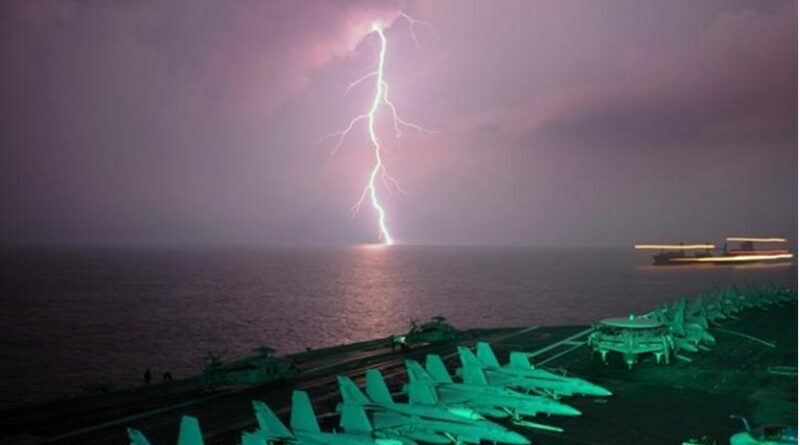The Latest US Spin On Its South China Sea FONOPs Against China – Analysis
China has protested what it called a provocative US freedom of navigation operation (FONOP) by the US Navy destroyer Preble on 20 May near China-claimed Scarborough Shoal in the South China Sea. https://thediplomat.com/2019/05/south-china-sea-us-destroyer-conducts-freedom-of-navigation-operation-near-scarborough-shoal/
This was the Preble’s second FONOP targeting China’s claims this month and seemed to contradict last week’s statement by US Chief of Naval Operations Admiral John Richardson at a major security conference in Singapore that the US Navy has not stepped up the frequency of such FONOPs leading to confusion among friends and foes alike. https://thediplomat.com/2019/05/us-navy-chief-us-hasnt-stepped-up-sea-patrols-to-confront-china/;https://www.reuters.com/article/us-usa-southchinasea/chinas-attention-to-u-s-navy-operations-in-south-china-sea-sometimes-unwarranted-u-s-says-idUSKCN1SL0MK; https://www.navytimes.com/news/your-navy/2019/05/15/why-the-us-navys-top-admiral-says-it-hasnt-stepped-up-sea-patrols-to-confront-china/
Richardson had declared “I’ve done the analysis and I can state with confidence that our level of operations, our presence there [in the South China Sea], has been consistent over the decades. There is nothing that has spiked recently.” “We haven’t done anything increasingly provocative or anything else.”
It is not clear from the various news reports of Richardson’s comments whether he was trying to bury the obvious uptick in US military activities in the South China Sea in the mass of FONOPs the U.S. has undertaken throughout the world from the beginning of the FONOPs program, or if he was simply denying that they have increased in the South China Sea. The former would be disingenuous and the latter is just not true, unless of course there are many unpublicized FONOPs But this would be contrary to his vow that US FONOPs will proceed “with transparency, consistency and predictability”.– which this advocate of ‘transparency’.
The frequency of acknowledged US FONOPs targeting China’s claims in the South China Sea has recently increased. This calendar year the US has already conducted four FONOPs targeting China’s claims including the two this month. https://www.urdupoint.com/en/world/us-warship-spotted-near-disputed-islet-in-sou-625795.html That is an average of almost one a month compared to one every two to three months in previous years. Moreover, two ship FONOPs have become much more frequent that the usual one ship foray. https://www.scmp.com/news/china/diplomacy/article/2186461/us-steps-freedom-navigation-patrols-south-china-sea-counter
Even more disingenuous, Richardson tries to disconnect the increased and enhanced FONOPs from the broader context of US-China relations. Making matters worse, he was speaking to an audience of Asian military leaders who know better. US-China military relations have become increasingly tense including in the South China Sea. US National Security Advisor John Bolton has made it clear that the U.S. is preparing to build up its forces in the region and in particular its patrols in the South China Sea. https://www.straitstimes.com/asia/se-asia/duterte-says-china-already-in-possession-of-south-china-sea-tells-us-to-end-military
On 12 February 2019, Admiral Phil Davidson, the US Indo-Pacific Commander told a US Senate panel that “Pacific forces_ _ are being repositioned to better respond to conflicts_ _ in the South China Sea”. https://freebeacon.com/national-security/u-s-bolstering-pacific-military-forces-to-counter-massive-beijing-buildup/
The U.S. has also stepped up its naval transits of the Taiwan Straits – even one is an anathema to China’s leaders – from about one a year at most to about once a month since October 2018. https://news.usni.org/2019/04/29/two-u-s-warships-pass-through-taiwan-strait-in-7th-transit-since-2018 Moreover, its”continuous bomber presence missions” that deploy nuclear capable aircraft over the South China Sea must appear to China to be a clear threat. https://www.airforcetimes.com/news/your-air-force/2018/06/06/us-b-52s-again-fly-in-contested-airspace-of-south-china-sea-claims/
To some Chinese military leaders, the U.S. appears to be flaunting its superior military power and daring China to take the political and military risk of confrontation and possible conflict. This is the context of the shift in policy emphasis indicated by the increased frequency of its FONOPs there.https://thediplomat.com/2019/05/south-china-sea-2-us-navy-destroyers-conduct-freedom-of-navigation-operation-in-spratlys/
But perhaps Richardson’s most incredibly naïve or disingenuous comment was that US FONOPs “are by design non-provocative, non-escalatory.” That may be the US intent, but Richardson well knows that China views the FONOPs as a threat of use of force. After an 11 February FOMOP near Mischief Reef, Chinese foreign ministry spokeswoman Hua Chunying said “The relevant actions of the US warships violated Chinese sovereignty, and undermined peace, security, and order in the relevant sea areas,” and called for the U.S. to “immediately stop its provocative actions_ _” https://www.maritime-executive.com/article/two-u-s-destroyers-conduct-fonops-near-mischief-reef A Chinese military spokesperson said Chinese warships and aircraft were dispatched to ward off the US destroyers_ _”. https://www.washingtontimes.com/news/2019/feb/13/inside-the-ring-us-destroyers-in-disputed-waters/
That China considers these FONOPs provocative was demonstrated by what the U. S. called its “unsafe” and “unprofessional” conduct that nearly caused an October 2018 collision between a Chinese warship and the US warship Decatur while it was executing a FONOP. https://www.foxnews.com/us/chinese-destroyer-made-unsafe-and-unprofessional-move-toward-uss-decatur-in-south-china-sea-official-says
This near conflict is still generating concern throughout the region. Richardson was apparently trying to calm nervous Southeast Asian countries. But he was not preaching to the choir. Some like Malaysia, Thailand, Vietnam and Indonesia also have restrictions on foreign warships operating in waters under their jurisdiction without their consent. And while some others may agree with the US legal interpretation of freedom of navigation for warships, they do not support their use to enforce its interpretation. Indeed, after the October 2018 Decatur incident, Singapore’s Defense Minister Ng Eng Hen said that “Some of the incidents are from assertion of principles, but we recognize that the price of any physical incident is one that is too high and unnecessary to either assert or prove your position.” Philippines President Rodrigo Duterte said that ” _ _ the threat of confrontation and trouble in the waterway came from outside the region.” https://ww.scmp.com/news/china/diplomacy/article/2173174/south-china-sea-asean-beijing-continue-wrk-towarss-code
Malaysian Prime Minister Mahathir Mohamad argues that “big warships [in the South China Sea] may cause incidents and that will lead to tension.” https://www.straitstimes.com/asia/se-asia/mahathir-tells-us-no-warships-in-asean-waters-but-small-patrol-boats-are-fine
The problem for Richardson and the U.S. is that few if any Asian military leaders believe that the U.S. has not stepped up its FONOPs and other military activities targeting China or that they are not provocative. Such assurances ring hollow. China and Southeast Asian countries will continue to make their decisions based on actions, not the latest spin.

